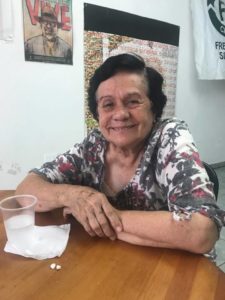It was a sunny day in Culiacán, the capital of both Sinaloa state in northwest Mexico and, arguably, of the entire drug trade in the Western hemisphere. I was at a café to meet Angela,* an ex-model and beauty queen.
Born and raised in Culiacán, when she was a little girl Angela wanted to be a vet. “I became a model by accident, after I took part in a beauty pageant where I was discovered by a woman in an agency,” she said. “It was easy money and I also worked as a hostess—it’s very normal at these type of agencies to provide girls working as hostesses.”
In countries like Mexico, Colombia and Honduras, participation in pageants is frequently tied to involvement with gang members. In the macho world of the narcos, having a beauty queen at your side is a status symbol, and cartels often bankroll beauty contests to facilitate this.
“We all knew she was gonna win because she was with this big fish.”
“There was this one guy I met… He’d never tell you what he does but by the car he drives, you can tell he’s in the business,” Angela said. “All the men around here like to have mistresses, and all the women know but they try to ignore it so they can have a sweet life. But this guy I was dating had too many and that made me uncomfortable.”
The allure of narco-bling, sports cars and all-expenses trips to Cancún is obvious. But then there’s the other, sinister side.

The Jardines Del Humaya outside Culiacán, known as a “narco-cemetery”
“I was at this one beauty contest where all the models were congregated in this hotel,” Angela remembered. “I met a girl there who was involved with a trafficker, and he’d sent her a big flower bouquet the size of a wall! We all knew she was gonna win because she was with this big fish.”
That young woman, 20-year-old María Susana Flores Gámez, duly won Miss Sinaloa 2012. Just a few months later, she was gunned down when the car she was riding in was ambushed by soldiers. Her boyfriend, Iván “‘El Cholo” Gastelum Cruz—a close associate of none other than Joaquín “El Chapo” Guzmán, erstwhile leader of the once all-powerful Sinaloa cartel—survived.
“I sensed something wasn’t right and walked away.”
After that, Angela usually kept her distance. “Once my friends told me, ‘There’s this party, do you want to come?’” she recalled. “Then we got there and you could tell it’s a narco house because of all the opulent decorations, and there was a few well-dressed men from Colombia and Venezuela. I sensed something wasn’t right and walked away.”
She probably made the right call. Mexico suffers sickening rates of violence against women, much of it directly or indirectly connected with the narco business. Nine women are murdered each day, according to the latest data from the UN. Of more than 50,000 murders of women since 1985, over a third took place since 2010—the height of the country’s brutal drug wars. The general killing surged in the mid-2000s, partly from turf wars between cartels and partly because the government started taking out bosses, upsetting the usual pecking order and sparking the “freelancer effect.”
When a war broke out between El Chapo and the rival Zetas cartel, they kidnapped his ex-girlfriend, Zulema Hernández. Her body was later found in a car trunk with the letter “Z” carved into her breasts and buttocks. She had been murdered merely to send a warped message to Chapo.
Of course, not all women in the narco world are victims or bystanders. A few, like Sandra Ávila Beltrán, known as the “Queen of the Pacific,” rise above the sexist culture to reach the highest echelons of the cartel hierarchy—in her case, becoming the crucial link between the Sinaloans and their Colombian suppliers.
Others, such as Melissa Calderón, aka “La China,” become ruthless enforcers. Calderón was a savage operator even by Mexican cartel standards—once slaughtering an entire family so she could take their truck, then killing one of her own men after he protested.
“That’s what happens when you say no to a narco; they’re used to getting whatever they want.”
But those are exceptions to the rule. For the most part, the narco world is heavily misogynistic.
“Another time I was at my mother’s village. There was some dancing and I saw this guy with 20 armed men,” Angela told me. “One of them comes up to me and asks me to dance, and I politely said no. He muttered something to his boss who came up and sat next to me, saying, ‘Why don’t you wanna dance with me?’ I said, ‘My skirt is too short.’ I was getting uncomfortable so we got up to leave, but we were followed.”
“So when we got home we locked all the doors, and that’s when they started shooting in the air outside. That’s what happens when you say no to a narco; they’re used to getting whatever they want. They’ll go to the villages and take whatever girl then bring her to the boss.”
Atrocities Against Refugees
Mexico’s drug wars have seen atrocities perpetrated on an incomprehensible scale. In 2010 the bodies of 72 immigrants from Brazil, Ecuador and Central America, including a pregnant woman, were unearthed in a mass grave near the town of San Fernando in the state of Tamaulipas, in Zetas territory. Their only “crime” was seeking to head north to the US.
While powerful cartels like the Zetas don’t usually smuggle people across the border themselves, they collect taxes from those who do, as well as from the immigrants themselves. Failure to pay up is believed to have prompted the massacre.
Then in 2011, the authorities found more bodies at a ranch in San Fernando (again), killed by the Zetas (again). This time, buses carrying 193 men, women and children were run off the road. Several of the passengers were lined up in front of a bus and the driver was forced at gunpoint to run them over. Women were raped before being murdered, children thrown into acid baths, men forced to club each other to death for the Zetas’ entertainment.
As many as 80 percent of women and girls trying to reach the United States are raped.
Hellish acts like these highlight another aspect of the drug war’s violence against women: Immigrant and refugee women, particularly those from Central America, are especially vulnerable. As many as 80 percent of women and girls trying to reach the United States are raped—so many that according to Amnesty International and law enforcement, some decide for this reason to get contraceptive injections before setting out.
The trauma and devastation are visible north of the border. “In San Diego you’d see crimes against undocumented persons as they swept in the country, on the front line,” Norm Stamper, a former captain in the San Diego police force who now advocates for drug policy reform, told me. “You’d see children’s underpants with blood on them, rocks the size of grapefruits with blood on them. In other words, evidence of rape, robbery and murder. It’s not uncommon to harvest dozens of bodies in those hills in a given year.”
The immigrants—or let’s call them what they are, refugees—are fleeing violence of warzone proportions in their home countries of Honduras, El Salvador and Guatemala. In 2014 a truce between the two biggest maras (gangs) in El Salvador, Barrio 18 and Mara Salvatrucha, fell apart. Whole neighbourhoods were cleared out for urban warfare. That same year, 67,339 unaccompanied children came over the US-Mexico border. Even in the pre-Trump era, politicians responded with the usual rhetoric about securing the border—a callous reaction that would have sent children back to the slaughter.
Since then, the expansion of drug cartels in Honduras and Guatemala, bolstered by their ties to the wealthy, land-owning elite, has thrown more fuel on the fire. The Central American maras also work for the cartels as guns-for-hire, helping protect cocaine shipments.
An Entire System Targeting Women
But violence against women isn’t limited to the narcos. The cartels have only been able to amass so much power in Mexico by getting police, politicians and other players on their payroll. The original core of the Zetas comprised former members of the Mexican special forces. Police and federal forces frequently terrorize peaceful civilians while supposedly doing their jobs. Murder, cover-ups and kidnappings are all routine, while torture is fairly standard procedure for investigating crimes.
“The problem in Mexico is there’s only one way to investigate: torture,” Mercedes Murillo, the head of a Sinaloan human rights NGO, told me. “On paper, we have very good laws in Mexico—one law is if you confess by torture, they have to let you out. But they don’t do that. They don’t even need a crime, they can say whatever they want. It’s all the police, all over Mexico.”

Mercedes Murillo
Murillo, a veteran campaigner who runs the Sinaloa Civic Front, is in her 80s but has the appearance, drive and energy of a much younger woman. As we sat in her office in Culiacán, a picture of a young girl on the wall caught my eye.
“That’s a girl, we helped her: Yecenia Graciano,” she said. “She was tortured. The judge knew. They raped her. The took her clothes off, and sent people in to torture the girl. There was no investigation. She’s a nice girl. We got her out of jail, but she was there for many months. And there are people like her every day.”
In a grim pattern seen in wars of every kind, both narcos and soldiers use rape and gender violence as a tool.
Police brutality has always been a problem in Mexico, as in many countries. But the war on cartels has given a new excuse for the worst possible abuse of power.
In a grim pattern seen in wars of every kind across the world, both narcos and soldiers use rape and gender violence as a tool, similar to gruesome execution videos, to goad and humiliate the enemy, and keep local people cowering in fear. Like soldiers, gang members feel a sense of brotherhood and camaraderie, and in some cases wartime rape might be a twisted form of bonding. And being a cartel hitman or a corrupt cop offers such impunity that those people with prior inclinations to sexual violence and sadism feel free to act on them.
There’s a common thread tying these many forms of violence and brutality together. A gram of coke is expensive, and it’s expensive because it’s illegal—allowing a small group of opportunistic, ruthless people to make vast sums of money and obtain unfettered power (in turn allowing them to diversify into other areas, like extortion of refugees). All this abuse and death is ultimately the consequence of prohibition.
Angela walked out on her narco boyfriend and stayed out. Many others weren’t so lucky. The death toll in Mexico keeps climbing.
*Name has been changed to protect source.
Miguel Angel Vega contributed to the reporting in this article.
Top photo shows a mural in northern Mexico. All photos by Niko Vorobyov.





Show Comments